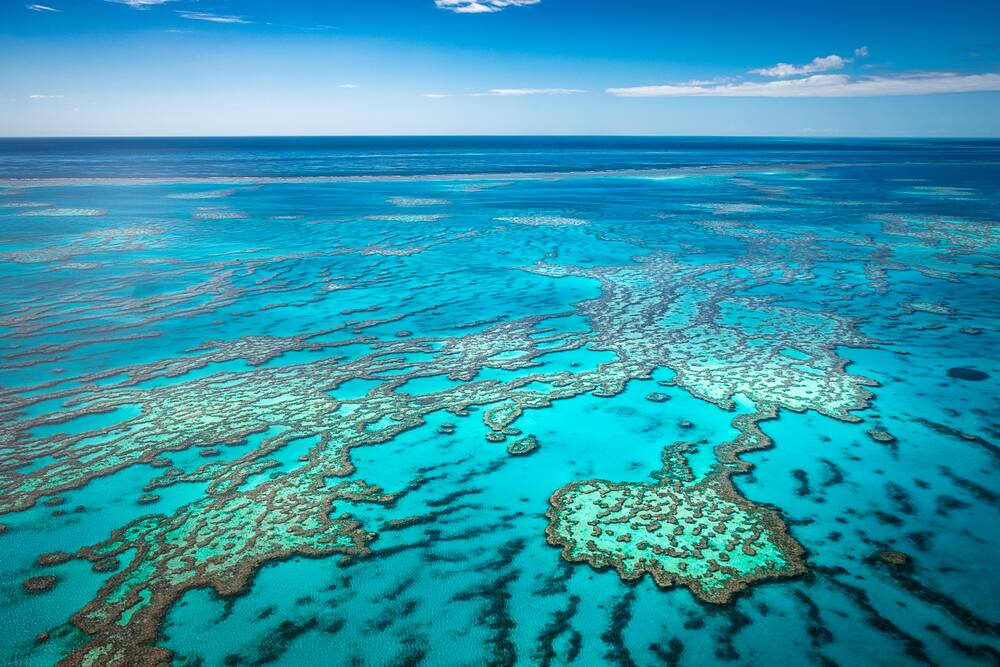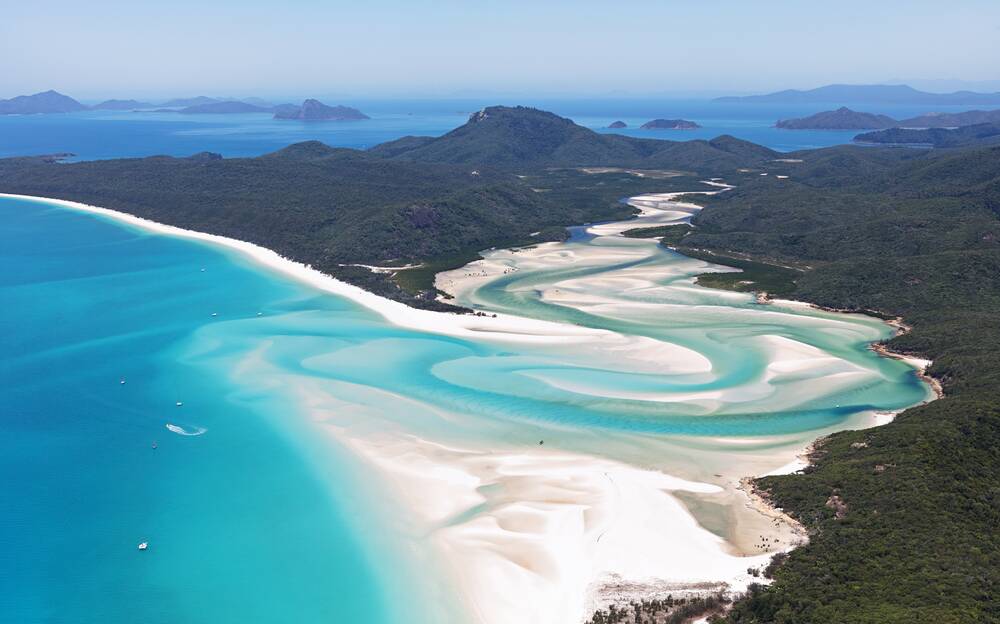Visiting the Great Barrier Reef: A guide

This is branded content.
As the Great Barrier Reef stretches for over 2000km, it can be tricky to know exactly where to begin when it comes to exploring all that the reef has to offer.
Thankfully, there's plenty of laid back and luxury accommodation like the Sheraton in Port Douglas along the length of the idyllic and expansive Queensland coastline that'll allow you to stop and take in each and every sight that's been deemed well worth seeing during your time in and around the reef.
Many avid reef explorers have stated that the best way to experience the Great Barrier Reef is by starting from North Queensland around Cape Tribulation and the Daintree Rainforest, and then heading south until you reach Airlie Beach and the Whitsunday Islands.
We'll be following this same route and mapping out all the experiences that should be added to your own trip itinerary.
Explore the length of the Great Barrier Reef Drive
You can kick start your epic journey across Australia's north-east coast by following the winding Great Barrier Reef Drive, a highly scenic coastal roadway that stretches south from Cape Tribulation and all the way down to Cairns, with a variety of bustling town centres and tourist attractions to take in along the 140km long journey.
Starting off in Cape Tribulation is always a superb bet as you'll be able to enjoy the incredible views of where the Daintree Rainforest meets the reef, with luscious rainforests framing the western side of Captain Cook Highway, and the full majesty of the expansive Coral Sea visible from your east.
We highly recommend stopping at some of the rainforest boardwalks that you'll find along the way from Cape Tribulation to the heart of the Daintree.
Cape Tribulation itself is home to the Kulki and Dubuji boardwalks that follow the curvature of the coastline, allowing hikers to explore the transition from tree ferns and other rainforest flora to coastal mangrove forests.
The mangroves that dot the coastline along the Great Barrier Reef Drive are actually the breeding and feeding grounds for many fish species that call the reef home, meaning that an exploration of these coastal landscapes may see you witnessing the shimmering flashes of crabs, sea turtles, and a few pods of fish in the shallows as you hike.
There are plenty of picturesque beaches to visit along the length of this roadway too, including Four Mile Beach by Port Douglas, as well as Ellis Beach and the ever-popular Palm Cove.
Feel free to set aside a day or two just to explore these beautiful beaches and their surroundings, as there are plenty of trails to stroll through and local eateries to enjoy that'll be sure to enhance your Queensland road trip experience.
Fly, sail, or paddleboard across the Coral Sea
If you're looking to head out onto the reef itself, there are an abundance of local guides from both contemporary marine conservation backgrounds as well as from First Nations backgrounds who will be able to facilitate a tour of the stretches of reef area that they are most familiar with.
In fact, many Port Douglas hotels may just have their own tours on offer, or at least resources detailing to their guests where they'll be able to find their region's recommended touring services.
Whilst there are some benefits to booking a guided tour of the reef, some areas will allow independent explorers to engage with the reef without any local guides, either by renting a private boat or even by setting out on a kayak or paddleboard to nearby reef areas.
If you are looking to head out on the water independently, however, you should absolutely keep in mind that powered yachts or other motorised vessels like jetskis, may disturb marine life and as such, there could be local sanctions on the recreational use of these vessels in reef areas.
Of course, a bird's eye view of the Great Barrier Reef can oftentimes be just as enriching as swimming in the Coral Sea itself.
As the reef stretches on for hundreds of kilometres in both directions along the length of the Great Barrier Reef Drive, it is certainly a sight to behold from the air, and so if you do have the time and funds to spare on a helicopter tour of the reef region, we're here to confirm that this would be a more than worthy investment.
Visit the Museum of Underwater Art
Moving further south now to the city of Townsville, you'll find an attraction that's only just recently opened its figurative doors to friends of the reef coming from far and wide.
The Museum of Underwater Art is by no means a museum in a traditional sense. It doesn't actually have opening hours, or yes, even windows, floors, or doors.
Instead, the museum's curator, award-winning underwater sculptor Jason deCaires Taylor, originally developed the series of breathtaking underwater sculptures that make up this attraction in order to make the reef a literal work of art alongside already being one of Mother Earth's most impressive artworks and one of the world's most cherished natural wonders.
DeCaire Taylor's sculptures have been fitted with coral larvae so that they eventually become living coral ecosystems themselves once they are submerged and installed across the reef, with one particular sculpture - the Coral Greenhouse located at John Brewer Reef - having been designed to dissipate the ocean's undercurrents and thus, provide marine life with a more stable ecosystem.
DeCaire Taylor hopes that all of his sculptures may play a role in both revitalising sections of the reef that have faced duress as a result of the ongoing climate crisis, as well as encouraging tourists to engage with the impacts of climate change and contemplate what we risk when we fail to prioritise sustainability in our day to day.

Go island hopping in the Whitsundays
As you travel further south from Townsville, you'll finally find yourself at the iconic Airlie Beach, a coastal haven renowned for its striking sands and views of the picturesque Whitsunday Islands.
The Whitsundays are actually the perfect place for you to conclude your exploration of the Great Barrier Reef, as there are plenty of opportunities in and around the islands to get up close and personal with sections of the reef that are particularly rich with biodiversity.
Some notable snorkelling spots include Blue Pearl Bay on Hayman Island, the reefs surrounding Hooke Island, and in and around the lengthy sand spit of Langford Island, just to name a few.
The aquamarine waters surrounding many of the Whitsunday Islands are also generally quite calm, so surface visibility is high.
Because of this, you won't necessarily even have to dive in order to have a look at some of the area's most fascinating flora and fauna. A glass-bottomed boat can reveal an entirely hidden world, and an accompanying tour guide may be able to provide you with some fascinating insights into the marine life that call the Whitsundays home.
Any avid kayakers or paddleboarders may even opt to head out on the water themselves and take full advantage of using unpowered vessels that will be less likely to spook the reef's inhabitants.
~
As the reef comprises an unfathomable variety of micro ecosystems and a hodgepodge of conservation zones and touring areas, there is certainly no set method for exploring all the beauty that the Great Barrier Reef boasts.
And this is absolutely fine. Unlike many of the Earth's natural wonders, the Great Barrier Reef cannot be experienced in its entirety during just one visit, which is why many explorers do find themselves returning to the Coral Sea time and time again.
For many Australians, the reef has been and always will be a destination that allows them to reconnect with the heart and soul of the island continent that they call home.
Experiencing its majesty in any capacity is an indefatigable privilege, and taking your family along with you will make your experience all the more humbling and enriching.


